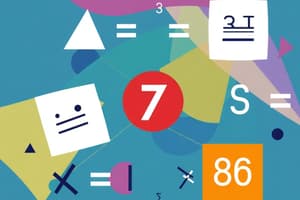Podcast
Questions and Answers
Which operation involves combining two numbers?
Which operation involves combining two numbers?
- Subtraction
- Division
- Multiplication
- Addition (correct)
In algebra, what does a variable represent?
In algebra, what does a variable represent?
- A type of shape
- A fixed number
- A symbol for numbers (correct)
- An operation
What does the Pythagorean theorem relate to?
What does the Pythagorean theorem relate to?
- Spheres
- Right triangles (correct)
- Cubes
- Circles
What is a derivative in calculus?
What is a derivative in calculus?
Which of the following is a type of descriptive statistic?
Which of the following is a type of descriptive statistic?
Which of these numbers is a prime number?
Which of these numbers is a prime number?
What does the formula $A = P(1 + r/n)^{nt}$ represent?
What does the formula $A = P(1 + r/n)^{nt}$ represent?
Which connective indicates a conjunction in logical statements?
Which connective indicates a conjunction in logical statements?
Flashcards are hidden until you start studying
Study Notes
Fundamental Concepts in Mathematics
1. Basic Arithmetic
- Addition (+): Combining two numbers.
- Subtraction (−): Removing one number from another.
- Multiplication (×): Repeated addition of a number.
- Division (÷): Splitting a number into equal parts.
2. Algebra
- Variables: Symbols (like x, y) representing numbers.
- Expressions: Combinations of numbers, variables, and operations (e.g., 2x + 3).
- Equations: Statements that two expressions are equal (e.g., 2x + 3 = 7).
3. Geometry
- Shapes:
- 2D: Triangle, Square, Circle
- 3D: Sphere, Cube, Cylinder
- Properties:
- Area, Perimeter, Volume
- Theorems:
- Pythagorean theorem for right triangles.
4. Trigonometry
- Functions: Sine (sin), Cosine (cos), Tangent (tan).
- Relationships: In right triangles and unit circles.
- Applications: Used in calculating angles and distances.
5. Calculus
- Limits: Value that a function approaches as inputs approach a point.
- Derivatives: Measure of how a function changes as its input changes.
- Integrals: Represent the area under a curve.
6. Statistics
- Descriptive Statistics: Summarizing data (mean, median, mode).
- Inferential Statistics: Making predictions based on data.
- Probability: Study of randomness and uncertainty.
7. Number Theory
- Prime Numbers: Numbers greater than 1 that have no divisors other than 1 and themselves.
- Divisibility Rules: Criteria to determine if one number can be divided by another.
- Greatest Common Divisor (GCD) and Least Common Multiple (LCM).
8. Financial Mathematics
- Interest:
- Simple interest: I = PRT (Principal x Rate x Time).
- Compound interest: A = P(1 + r/n)^(nt).
- Annuities: Series of payments made at equal intervals.
9. Mathematical Logic
- Statements: An assertion that is either true or false.
- Logical Connectives: AND, OR, NOT used to form compound statements.
- Proof Techniques: Direct proof, proof by contradiction, and induction.
10. Mathematical Symbols
- Common Symbols:
- ∑ (Summation)
- ∞ (Infinity)
- Δ (Delta, used for change)
- √ (Square root)
Study Tips
- Practice regularly: Work on problems to reinforce concepts.
- Use visual aids: Diagrams and graphs can aid understanding.
- Study in groups: Explaining concepts to others can enhance your grasp.
- Utilize resources: Books, online courses, and math apps for additional practice.
Basic Arithmetic
- Addition (+): combines two numbers to find their sum
- Subtraction (−): removes one number from another to find the difference
- Multiplication (×): repeated addition of a number to itself
- Division (÷): splits a number into equal parts
Algebra
- Variables: symbols like 'x' or 'y' that represent unknown numbers
- Expressions: combinations of numbers, variables, and mathematical operations (e.g., 2x + 3)
- Equations: statements asserting equality between two expressions (e.g., 2x + 3 = 7)
Geometry
- Shapes:
- 2D Shapes: examples include triangles, squares, and circles
- 3D Shapes: examples include spheres, cubes, and cylinders
- Properties: concepts like area, perimeter (for 2D shapes), and volume (for 3D shapes)
- Theorems: established mathematical principles, such as the Pythagorean theorem that applies to right triangles
Trigonometry
- Functions: trigonometric functions like sine (Sin), cosine (Cos), and tangent (Tan)
- Relationships: trigonometric functions relate angles and sides of right triangles, and they can be visualized on the unit circle
- Applications: used in calculating angles and distances in various fields
Calculus
- Limits: the value a function approaches as its input gets closer and closer to a specific point
- Derivatives: a measure of how a function changes as its input changes (slope of a tangent line)
- Integrals: represent the area under a curve or the accumulation of a quantity
Statistics
- Descriptive Statistics: summarizes data using measures like mean, median, and mode
- Inferential Statistics: uses data to make predictions or draw conclusions about a larger population
- Probability: studies randomness and uncertainty, determining the likelihood of events occurring
Number Theory
- Prime Numbers: numbers greater than 1 that are only divisible by 1 and themselves (e.g., 2, 3, 5, 7)
- Divisibility Rules: criteria for determining whether one number can be evenly divided by another
- Greatest Common Divisor (GCD): the largest number that divides two or more numbers without leaving a remainder
- Least Common Multiple (LCM): the smallest number that is a multiple of two or more numbers
Financial Mathematics
- Interest: the cost of borrowing money or the reward for lending money
- Simple Interest: calculated by I = PRT (Principal x Rate x Time)
- Compound Interest: calculated by A = P(1 + r/n)^(nt) (where n is the number of compounding periods per year)
- Annuities: a series of equal payments made at regular intervals
Mathematical Logic
- Statements: assertions that are either true or false
- Logical Connectives: operators like AND, OR, and NOT used to combine statements
- Proof Techniques: methods for establishing the truth of mathematical statements, including direct proof, proof by contradiction, and induction
Mathematical Symbols
- Common Symbols:
- ∑: represents the sum of a series
- ∞: denotes infinity
- Δ: (delta) signifies a change or difference
- √: indicates taking the square root
Studying That Suits You
Use AI to generate personalized quizzes and flashcards to suit your learning preferences.




